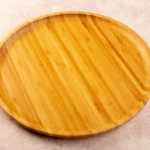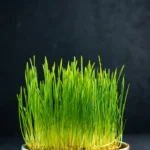Wheatgrass juice is a popular health drink because it is full of essential nutrients. Here are some of the key benefits:
Health Benefits of Wheatgrass Juice:

1. Rich in Nutrients:
Wheatgrass juice is loaded with vitamins like A, C, and E, and several B vitamins that are great for energy. It also has minerals like iron, calcium, and magnesium to help keep bones strong and energy levels up.
It’s got protein-building blocks called amino acids and a bunch of antioxidants that fight off things that can make us sick.
2. Boosts Your Immunity : Wheatgrass juice is like a little shield for your body . Thanks to the chlorophyll (the green stuff in plants), it helps strengthen your immune system, so you’re better protected against colds and other illnesses.
3. Helps with Digestion : Wheatgrass has natural enzymes that help break down food, making it easier for your stomach to digest and absorb all the good stuff.
It can also help with constipation or bloating, making you feel lighter and more comfortable.
4. Gives You a Natural Energy Boost: If you’re looking for an energy kick without the crash, wheatgrass juice might be perfect. It’s full of nutrients that help fight fatigue, so you feel more awake and ready to take on the day.
5. Supports Detoxification : Chlorophyll (the green stuff) works like a gentle cleanser, helping your liver get rid of toxins. So, wheatgrass juice is often included in detox routines to keep your body feeling fresh.
6. Good for Your Skin : Wheatgrass is high in antioxidants, which can help you get that natural glow and clear skin. It’s even used on the skin sometimes to reduce redness or help with minor irritations.
7. Supports Weight Loss : Since it’s low in calories but packed with nutrients, wheatgrass juice can make you feel fuller for longer without adding many calories. It can help with healthy weight management.
8. Helps Speed Up Your Metabolism: The nutrients in wheatgrass juice give your metabolism a little boost, which helps your body burn calories more efficiently.
9. Reduces Inflammation: Wheatgrass has natural compounds that help calm inflammation, which can be really helpful if you deal with conditions like arthritis or just want to keep your body feeling at its best.
10. Improves Blood Flow: Wheatgrass can help boost red blood cell production, making it easier for oxygen to reach different parts of your body and that’s good for energy and focus.
How to Start with Wheatgrass Juice:
Try a small amount at first (like a tablespoon), and see how your body reacts. You can work up to a “shot” (about an ounce) over time.
Growing wheatgrass at home is quite simple and doesn’t require much space Here’s a step-by-step guide to get you started:
1. Gather Your Supplies : Look for organic wheatgrass or hard red winter wheat seeds.

Growing Tray or Pot: A shallow tray or pot (1-2 inches deep) with drainage holes works well.

Soil : Use organic potting soil, preferably without chemical fertilizers.
Spray Bottle: To keep the soil moist without overwatering.
2. Seed preparation:
Rinse the Seeds: Rinse about 1-2 tablespoons of seeds to remove any dust.
Soak Overnight: Place the seeds in a bowl, cover them with water, and let them soak for 8-12 hours. This helps them start sprouting faster.
Rinse and Drain: After soaking, drain the water, rinse the seeds again, and drain once more. Let them sit in a bowl for another 12 hours to sprout.
3. Prepare the Soil and Tray:
Add Soil to Tray: Fill your tray with 1-2 inches of potting soil and spread it evenly.
Moisten the Soil: Use your spray bottle to lightly mist the soil, so it’s damp but not soggy.
4. Plant the Seeds:
Spread the Seeds: Evenly sprinkle the sprouted seeds over the damp soil. They should cover the surface but not overlap too much.
Lightly Press Down: Gently press the seeds into the soil, but don’t bury them.
5. Cover and Water:
Cover the Tray: Place another tray or a thin layer of paper towels on top to block light for the first few days. This encourages the roots to grow deeper.
Keep Moist: Mist the seeds with water twice a day to keep them damp. Avoid overwatering, as too much water can cause mold.
6. Remove the Cover and Continue Growing:
Uncover After 2-3 Days: Once you see little green shoots, remove the cover and place the tray in indirect sunlight.
Water Regularly: Mist the grass daily, keeping it moist but not soaked.
7. Harvest Your Wheatgrass:

Ready in 7-10 Days: The wheatgrass will be ready to harvest when it’s about 6-8 inches, tall, which usually takes a week.
Cut at the Base: Use scissors to cut the grass close to the soil. This is your fresh wheatgrass for juicing!
8. Second Harvest (Optional) :
Wheatgrass often grows a second round of shoots after the first cut. You can water it lightly and wait for it to regrow for another harvest, although the second batch may not be as nutrient dense.
Tips to Keep in Mind:
Avoid Direct Sunlight: Wheatgrass prefers indirect light, as direct sunlight may cause it to wilt.
Keep an Eye Out for Mold: If you notice any white, fuzzy mold, it’s usually because the seeds are too wet or the room lacks ventilation. Using a fan can help keep airflow going and prevent mold growth.
Conclusion :
Wheatgrass juice is a small but powerful addition to your daily routine. Packed with nutrients, it offers a natural way to boost your immunity, detoxify your body, and improve your overall health. Whether you’re drinking it for energy, skin health, or just to feel more balanced, wheatgrass is an easy, accessible superfood that fits into almost any lifestyle.
If you’re just started, take a small amount of juice . Rather it’s taste is not to good but having plenty of health benefits in it. Growing wheatgrass at home can be a rewarding and cost-effective way to ensure you always have fresh, organic juice on hand.
FAQ:
1. What are the main Health Benefits of Wheatgrass Juice?
Wheatgrass juice is packed with vitamins (A, C, E, and several B vitamins), minerals (like iron, calcium, and magnesium), and antioxidants. It can boost immunity, improve digestion, detoxify the body, increase energy levels, and support clear skin. It’s also believed to aid in weight management, reduce inflammation, and improve blood circulation.
2. How much Wheatgrass Juice should I drink daily?
A typical serving size is 1-2 ounces per day. Wheatgrass juice is highly concentrated, so it’s best to start with a small amount (about 1 ounce) and see how your body responds. Some people find it energizing, while others may need time to adjust to its potency.
3. Can I grow Wheatgrass at home?
Yes Wheatgrass is easy to grow at home with minimal space and supplies . You need wheatgrass seeds, soil, a shallow tray, and a little sunlight. It usually takes about 7-10 days for the wheatgrass to be ready for harvesting. Growing it yourself ensures it’s fresh, organic, and cost-effective.
4. What’s the best way to juice Wheatgrass?
The best way to juice wheatgrass is with a masticating juicer, which is designed for leafy greens and preserves nutrients. If you don’t have one, you can use a blender with a bit of water, then strain the juice using a cheesecloth. Drinking it fresh is ideal to retain its nutrients.
5. Can I add Wheatgrass Juice to other juices or smoothies?
Absolutely , Many people find the flavor of wheatgrass to be strong, so adding it to other juices or smoothies make it more palatable. It pairs well with citrus fruits, apple, pineapple, ginger or even greens like spinach. This way, you still get the benefits while enjoying a tastier blend.
6. Are there any side effects of drinking Wheatgrass Juice?
Some people may experience mild nausea or stomach upset, especially if they’re new to wheatgrass. Start with a small amount to see how your body reacts. If you have a wheat or grass allergy or any health conditions, consult with a healthcare provider before adding it to your diet.
7. How does Wheatgrass Juice help with detoxification?
Wheatgrass juice is high in chlorophyll, which helps detoxify the liver and cleanse the blood. It also contains antioxidants that combat oxidative stress, promoting overall cellular health. Many people use it as part of a detox routine for this reason.
8. Can Wheatgrass Juice aid in weight loss?
Yes, wheatgrass juice is low in calories but high in nutrients, which can help curb hunger and reduce cravings. Its high fiber content and nutritional density make you feel fuller longer, potentially aiding in weight management as part of a balanced diet and lifestyle.
<head><script async src=”https://pagead2.googlesyndication.com/pagead/js/adsbygoogle.js?client=ca-pub-3317204152971892″
crossorigin=”anonymous”></script></head>
Pingback: Can Drinking Carrot Juice Improve Eyesight Eyesight – naturalaayucare